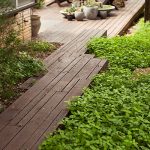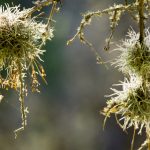This warm-season, deep-rooted, sun-loving bunchgrass grows in every ecoregion across Texas. It not only perseveres in all seasons, but sideoats grama also thrives without any additional water!
During the hottest months of the year when many other commonly used plants are shirking from the blazing heat, sideoats grama is boasting beautiful, ornamental inflorescence.
This warm-season, deep-rooted, sun-loving bunchgrass is distributed throughout North America and grows in every ecoregion across Texas.
Sideoats grama (Bouteloua curtipendula) has an incredibly vast root system, some estimate it to be around 8 feet deep! This is not what one would typically expect from a grass that is so commonly overlooked and that stands only 1 to 3 feet tall aboveground. Compare this root depth to the roots of commonly used (and drought-intolerant) St. Augustine, which are only a few inches deep.
Root system structure and size of various plants determines their ability to withstand long periods of drought. In fact, many native clumping grasses house most of their living tissue underground where they compete for available nutrients and water with other plant specimens.
This is an adaptation unique to prairie plants as the limiting resources for them are available nutrients and water. Contrast this with rainforest plants that have adapted broad leaves to absorb as much solar energy as possible (sunlight is in short supply in the dense canopy of the rainforest) and comparatively smaller root systems because water (which mobilizes nutrients) is ubiquitous in tropical environments.
The benefits of Sideoats grama and other prairie plants are myriad:
- Stabilizes soil, preventing erosion.
- Encourages groundwater recharge.
- Contributes to healthy waterways by increasing infiltration and filtering excess nutrients and pollutants such as oil, pesticides and fertilizers from storm water runoff.
- Provides food for birds and other beneficial wildlife in the form of seeds.
- Does not require any fertilizer to thrive, saving you money and reducing your impact on the ecosystem.
- Provides nesting sites and nesting material for beneficial, pollinating bumblebees and other wildlife.
- Persistent ornamental inflorescence throughout the summer and into fall.
- Aesthetically beautiful.
- Incredibly drought-tolerant, this plant thrives without additional water. Imagine how much water you won’t be using and how much money you will be saving by moving toward a drought tolerant landscape.
Since this ornamental grass is not commonly available in the nursery trade, the easiest way to get it started at your home is to collect seed and plant in your yard. It may be a good idea to lightly rake in the seed. The most important thing to remember about most native plants is never fertilize them and avoid overwatering.
This grass can grow to around 3 feet and looks great in prairie-inspired, sun-baked landscapes. Try planting with little bluestem grass, antelope-horn milkweed, Texas milkweed, Zizotes milkweed, narrow-leaf coneflower, blackfoot daisy, damianita and Wright’s skullcap, gayfeather and native penstemon for a low maintenance, eye-catching, pollinator-friendly garden that will persist in all seasons.
There are things we, as land stewards, seem to forget. Before fertilizers, lawn services, irrigation systems and “weed” killers, there existed here in Central Texas and much of the Midwest old-growth, grassland ecosystems that supported thousands upon thousands of species. It was simply a harmonious sea of grasses and flowering forbs.
The soil beneath us will still support many of these species. We just have to plant historically appropriate, native plant communities.




